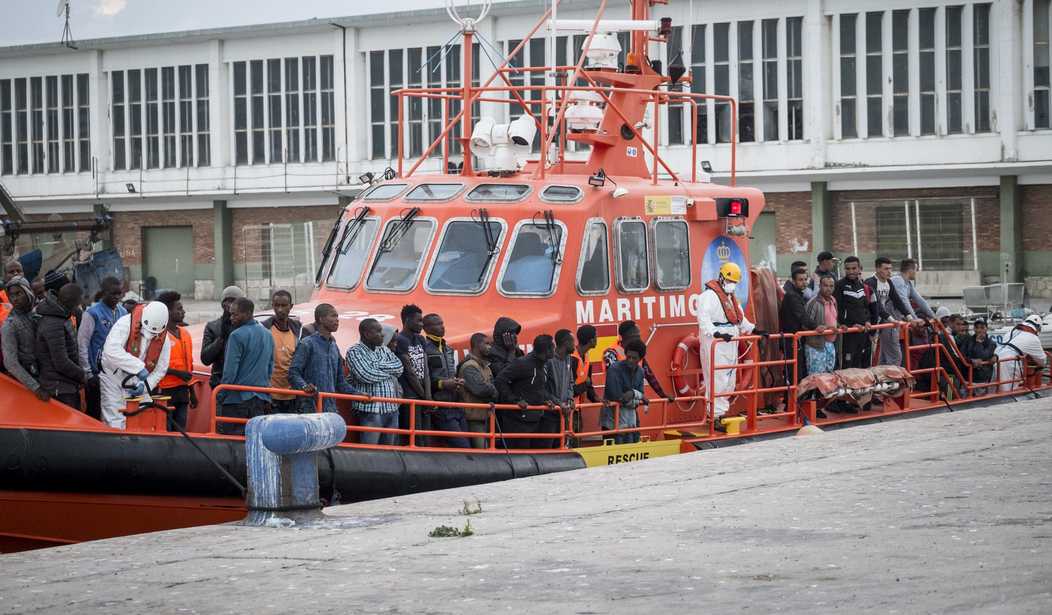Seafaring Muslim migrants from Africa are illegally entering and flooding Spanish territory. In just 2020, 23,000 migrants invaded Spain’s Canary Islands, representing a 234% increase.
That number has only continued to grow. Between just Oct. 20-22, 2023, 1,600 migrants reached the Canary Islands. According to one report,
Of the boats that arrived over the weekend, one on Saturday was carrying 320 migrants. The state news agency EFE said it was the largest number in a single boat since human traffickers began to regularly use the Canary Island route in 1994. The previous record of 280 was recorded earlier this month.
As another report on how 6,000 Muslims invaded Ceuta in 2021 explains, they come “by sea, either swimming or with inflatables, all in a bid to eventually get to mainland Europe.”
Once arriving on Spanish territory, such migrants invariably engage in unsavory and downright criminal behavior, such as gang rape, and create enclaves, or ribats, where police fear to tread. This is unsurprising since many of these Muslim-laden boats depart from Senegal, which, as part of the Sahel, has a strong jihadist presence.
Of note is that these African invaders are following the same strategy that led to the Islamic conquest of Christian Spain in the eighth century.
According to the “Chronicle of 754,” in 711, hordes of African Muslims (“Moors”) “godlessly invaded Spain to destroy it.” They did not pass “a place without reducing it, and getting possession of its wealth,” boasted al-Hakam, an early Muslim chronicler, “for Allah Almighty had struck with terror the hearts of the infidels.”
Such terrorism was intentionally cultivated, in keeping with the Koran (e.g., 3:151, 8:12). Indeed, very near or even on the Canary Islands, the eighth-century invaders slaughtered, cooked, and ate — or rather pretended to eat — their Christian captives, prompting hysteria among the people “that the Muslims feed on human flesh,” and thereby “contributing in no small degree to increase the panic of the infidels,” wrote another Muslim chronicler.
Emboldened by their coreligionists’ initial victories, and reminiscent of what is happening today, swarms of Africans “crossed the sea on every vessel or bark they could lay hold of,” the Muslim chronicler continues. They so overwhelmed the peninsula that “the Christians were obliged to shut themselves up in their castles and fortresses, and, quitting the flat country, betake themselves to their mountains.”
By 712, one year after the Islamic invasion, the Muslims had, in the words of the “Chronicle of 754,” “ruined beautiful cities, burning them with fire; condemned lords and powerful men to the cross; and butchered youths and infants with the sword.” Several other early sources corroborate the devastation and persecution. The oldest account, the “Tempore Belli,” tells of Muslims “sacking Christian temples [churches] and homes, burning the cities of those who resisted, and taking their young women as sexual slaves, all creating an indescribable terror.”
The difference between then and now is that the Christians fought back. With the fall of Spain to Islam, many Christians fled to the inhospitable northwestern quadrant of that Peninsula. Although the Muslims tried to conquer this mountainous region several times, they failed, and from it, the Reconquista — the Reconquest of Spain — was born.
In the words of the first Christian king to emerge following the Muslim conquest of Spain, Pelagius (or Pelayo, 685-737), “I will not associate with the Arabs in friendship nor will I submit to their authority… Christ is our hope that through this little mountain” — which he likened to the “mustard seed” of the famous parable that eventually grows into something great (Mark 4:30-32) — the “well-being of Spain … will be restored.”
And so it was. Century after century, the Christians militarily expanded from their northern strongholds into central and eventually southern Spain, until 1492, when virtually the whole of Spain had been brought back under indigenous rule.
In short, following the eighth-century Muslim conquest of Spain — which began with seafaring Africans reaching Spain’s shores — nearly eight centuries of brutal warfare were needed for the Christians to finally expel the Muslim invaders.
Meanwhile, rather than learn something from its own history, when it comes to taking in illegal migrants from Africa, today’s Spanish government is, in the name of “humanitarianism,” among the most welcoming in Europe.









Join the conversation as a VIP Member